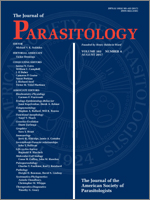Demodex mollis n. sp. is described from the yellow-necked mouse, Apodemus flavicollis (Melchior, 1834), from Poland. It is a medium-sized demodecid mite (adult stages are, on average, 249 μm long) observed in the skin of the eyelid area. This new species is most similar to two other species occupying similar a microhabitat in hosts of the same genus—Demodex lacrimalis Lukoschus and Jongman, 1974 from Apodemus sylvaticus Linnaeus, 1758 and Demodex huttereri Mertens, Lukoschus and Nutting, 1983 from Apodemus agrarius (Pallas, 1771)—but it differs in the following features: the terminal palpi are equipped with 3 spines, including 1 large claw-like spine and 1 single spine; subgnathosomal setae (setae n) are situated on both sides of the anterior side of the pharyngeal bulb; claws on the leg tarsi are bifurcated and each is equipped with large subterminal spur and proximal pointed projection; the opisthosoma is soft and flexible; and the male aedeagus has a different shape and localization. The differences also relate to sexual dimorphism. Males are more robust and stocky, epimeral plates I and IV are connected at the midline part of the podosoma, and epimeral plates II and III are separated. Females are slender, epimeral plates I–III are connected at the midline of the podosoma, and epimeral plate IV ia fused in 1 plate. The new species was noted in 22.5% of mice, with a mean intensity of 7.0 parasites per host. The topography of demodecid mites was also analyzed in the skin of A. flavicollis, and also Demodex corniculatus Izdebska, 2012 was observed in the hairy skin of the bodies of all the examined mice.
BioOne.org will be down briefly for maintenance on 12 February 2025 between 18:00-21:00 Pacific Time US. We apologize for any inconvenience.
How to translate text using browser tools
1 August 2017
Adult and Immature Stages of the New Species of the Genus Demodex (Acariformes: Demodecidae) with Data on Parasitism, Topography, and Topical Specificity of Demodecid Mites in the Yellow-Necked Mouse, Apodemus flavicollis (Rodentia: Muridae)
Joanna N. Izdebska,
Leszek Rolbiecki,
Sławomira Fryderyk,
Łukasz Mierzyński
ACCESS THE FULL ARTICLE

Journal of Parasitology
Vol. 103 • No. 4
August 2017
Vol. 103 • No. 4
August 2017




